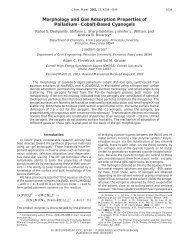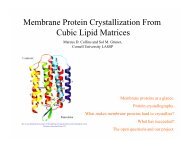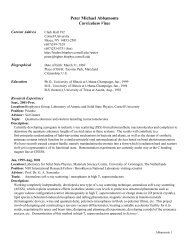Structural and Thermodynamic Characterization of T4 Lysozyme ...
Structural and Thermodynamic Characterization of T4 Lysozyme ...
Structural and Thermodynamic Characterization of T4 Lysozyme ...
You also want an ePaper? Increase the reach of your titles
YUMPU automatically turns print PDFs into web optimized ePapers that Google loves.
(8). Note that the mutation, E108V, was not included in this analysis because the 108 th residue is on thesurface <strong>of</strong> the protein. We therefore do not expect differences in the hydration <strong>of</strong> Glu (E) <strong>and</strong> Val (V), tocontribute differently to the volume change <strong>of</strong> denaturation. The predicted results in Table 3 show inparticular, the failure to account for the observed behavior <strong>of</strong> A98L <strong>and</strong> V149G. The #V° <strong>of</strong> V149G waspredicted to be as large in magnitude as L99A, while that <strong>of</strong> A98L was predicted to be very small inmagnitude, roughly half <strong>of</strong> the experimentally observed value.The failure <strong>of</strong> this method to estimate mutation-induced changes in cavity volumes is not surprising.Previous crystallographic studies <strong>of</strong> <strong>T4</strong> lysozyme have also shown that structural changes due to amutation cannot be easily predicted. At some buried sites, a large-to-small amino acid substitution in <strong>T4</strong>lysozyme created or enlarged a cavity, while at other sites, a similar mutation caused a rearrangement <strong>of</strong>the protein that filled the cavity (53). Moreover, for mutations that permitted the creation or enlargement<strong>of</strong> cavities, the new cavity volume could not be simply predicted by a side-chain analysis using the WT*structure <strong>and</strong> the van der Waals volumes <strong>of</strong> the exchanged amino acids. In the case <strong>of</strong> L99A, the changein cavity size is slightly smaller than expected. An extreme case was L99G <strong>T4</strong> lysozyme. Unlike L99A,the L99G mutation exposes the large cavity to the solvent. A second mutation, E108V, far from thecavity <strong>and</strong> on the surface <strong>of</strong> the protein was required to close the opening <strong>of</strong> the molecule’s surfacecreated by the L99G mutation (16). The structural changes caused by a small-to-large amino acidsubstitution such as A98L are less predictable (18).Crystal structures <strong>of</strong> <strong>T4</strong> lysozyme were thus necessary to quantify cavity volumes. The internalcavities <strong>of</strong> the mutants identified with a 1.2 Å probe are shown in Figure 1 (b)-(f), <strong>and</strong> thecorresponding volumes are presented in Table 2. An inspection <strong>of</strong> the crystal structures explains thelarge discrepancies between the experimental #V° <strong>and</strong> that predicted by side-chain volume analysis forA98L <strong>and</strong> V149G (Table 3). The A98L mutation does not fill the cavity at the mutation site, but instead,causes the strain-induced formation <strong>of</strong> several small cavities throughout the protein (Fig. 1 (d)).Therefore the total cavity volume is greater than that predicted by side-chain volume analysis. In thecase <strong>of</strong> V149G, the mutation not only enlarges a cavity (Fig. 1 (e)) but this cavity accommodates two20









